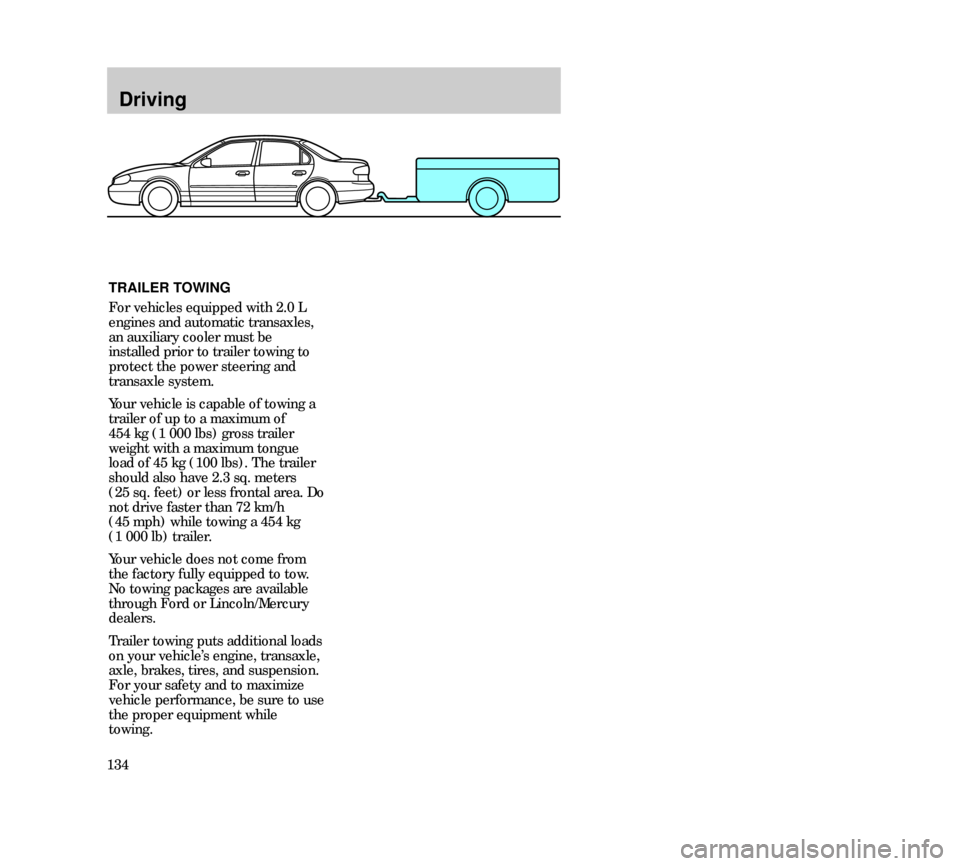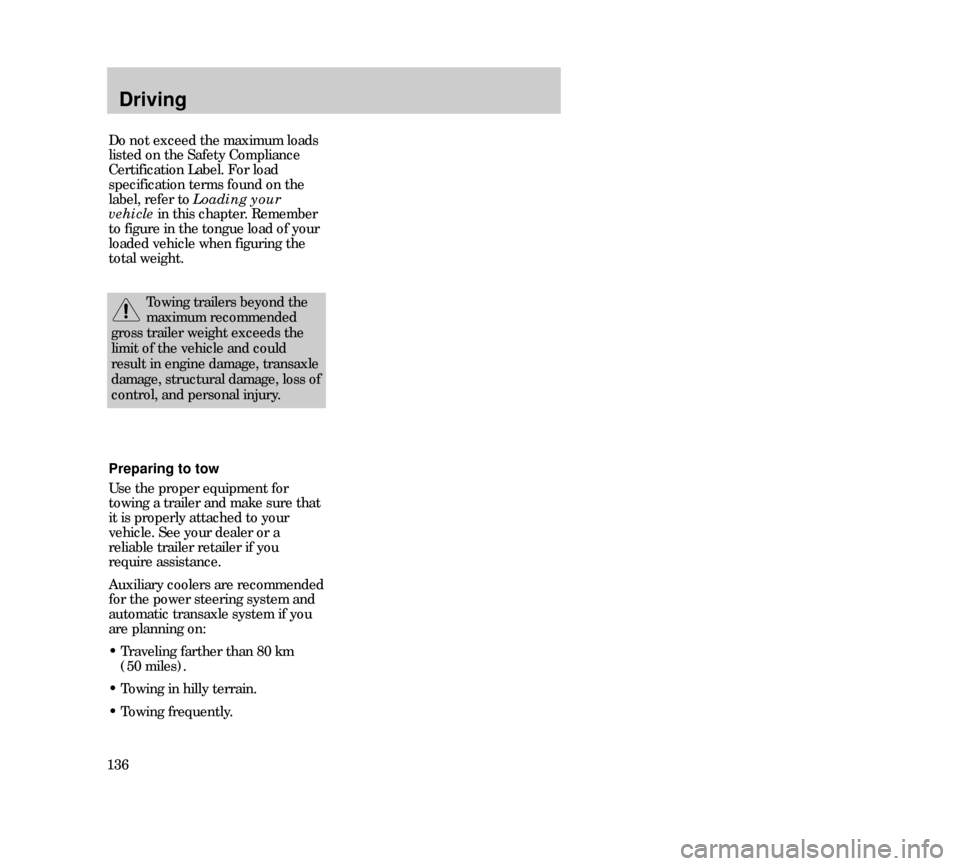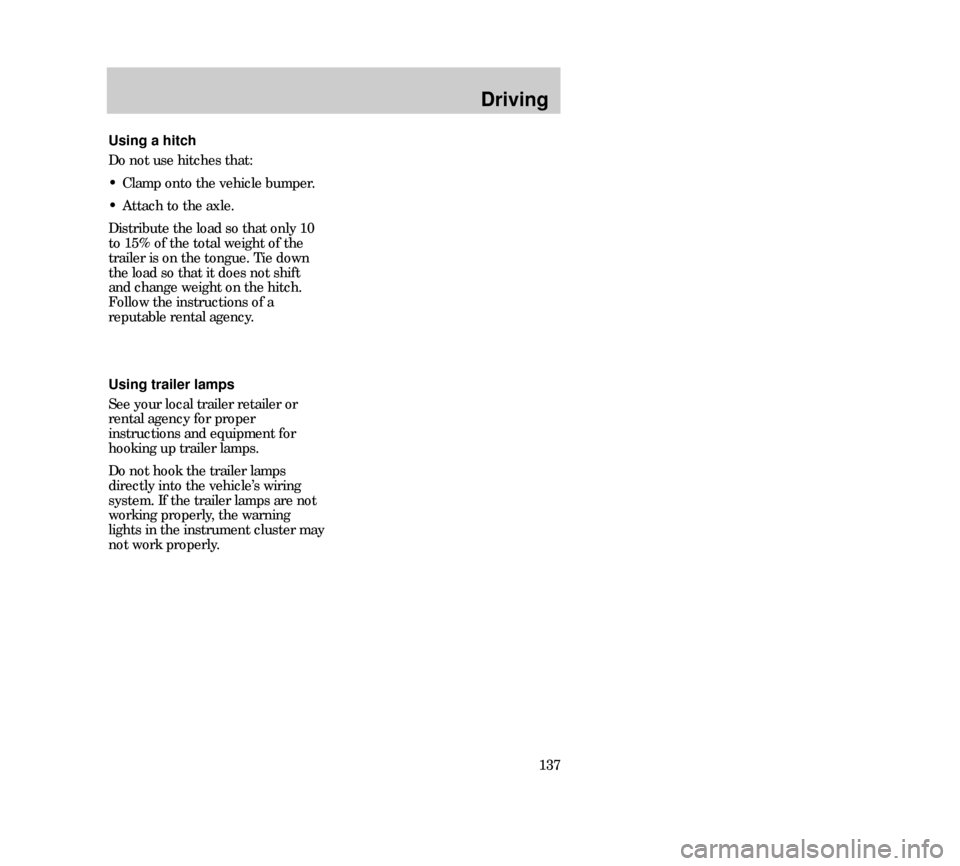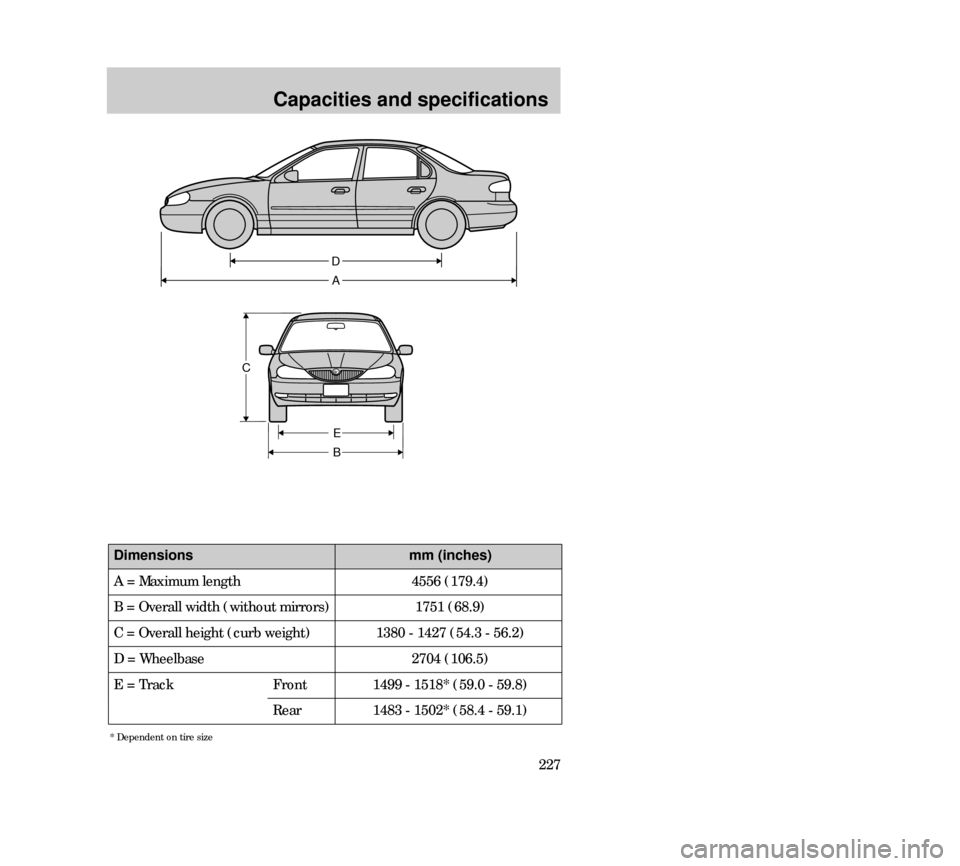weight Mercury Mystique 2000 Owner's Manuals
[x] Cancel search | Manufacturer: MERCURY, Model Year: 2000, Model line: Mystique, Model: Mercury Mystique 2000Pages: 248, PDF Size: 2.2 MB
Page 130 of 248

Driving
130LOADING YOUR VEHICLE
Before loading your vehicle,
familiarize yourself with these
terms.
GVW (Gross Vehicle Weight)
Base curb weight plus the payload
weight. The GVW is not a limit or a
specification. Payload
Combined maximum allowable
weight of passengers, cargo and
optional equipment. Base curb weight
Weight of the vehicle including any
standard equipment, fluids and
lubricants. It does not include
passengers or aftermarket
equipment.
22MDren 24.6.99 15:26 Uhr Seite 130
Page 131 of 248

Driving
131 GCW (Gross Combined Weight)
The GCW is the maximum
combined weight of the towing
vehicle (including passengers and
cargo) and the loaded trailer. The
GCW is specified by the
manufacturer to indicate the
combined maximum loaded weight
that the vehicle is designed to tow. GAWR (Gross Axle Weight
Rating)
Carrying capacity for each axle
system (front and rear). The
GAWR is specific to each vehicle
and is listed on the Safety
Compliance Certification Label on
the driver’s door pillar. GVWR (Gross Vehicle Weight
Rating)
Maximum total weight of the base
vehicle, passengers, optional
equipment and cargo. The GVWR is
specific to each vehicle and is listed
on the Safety Compliance
Certification Label on the driver’s
door pilar.
22MDren 24.6.99 15:26 Uhr Seite 131
Page 132 of 248

Driving
132
-9%
-6%
-3% 900 m
(3000 ft)
600 m
(2000 ft)
300 m
(1000 ft)
0 Payload = GVWR minus Base
curb weight
To obtain the correct weight for
your vehicle, try taking your
vehicle to a shipping company or
an inspection station for trucks.
Do not use replacement tires with
lower weight capacities than the
originals because they might lower
the vehicle’s GVWR and GAWR.
(Replacement tires with a higher
weight limit than the originals do
not increase the GVWR and GAWR
limitations.)
In high altitudes, engines will lose
power at a rate of 3% power per
300 m (1 000 ft) increase in
elevation. A reduction in GVW and
GCW is recommended for
maximum vehicle performance.
Do not exceed the GVWR or
the GAWR specified on the
Safety Compliance Certification
Label.
22MDren 24.6.99 15:26 Uhr Seite 132
Page 133 of 248

Driving
133
It is extremly dangerous to
ride in a cargo area, inside or
outside of a vehicle. In a collision,
people riding in these areas are
more likely to be seriously injured
or killed. Do not allow people to
ride in any area of your vehicle
that is not equipped with seats
and safety belts. Be sure everyone
in your vehicle is in a seat and
using a safety belt properly.
Driving with a heavy load
The total weight of the vehicle plus
the total weight of passengers and
cargo should never exceed the
GVWR.
The weight that the vehicle carries
over the front and rear axles
should never exceed the GAWR for
the respective axle.
The weight limits of your vehicle’s
tires affect the GVWR and GAWR
limitations. Using tires with higher
weight limits than the original tires
will not increase the GVWR or
GAWR of your vehicle; using tires
with lower weight limits may lower
the GVWR or GAWR of your
vehicle.
22MDren 24.6.99 15:26 Uhr Seite 133
Page 134 of 248

Driving
134TRAILER TOWING
For vehicles equipped with 2.0 L
engines and automatic transaxles,
an auxiliary cooler must be
installed prior to trailer towing to
protect the power steering and
transaxle system.
Your vehicle is capable of towing a
trailer of up to a maximum of
454 kg (1 000 lbs) gross trailer
weight with a maximum tongue
load of 45 kg (100 lbs). The trailer
should also have 2.3 sq. meters
(25 sq. feet) or less frontal area. Do
not drive faster than 72 km/h
(45 mph) while towing a 454 kg
(1 000 lb) trailer.
Your vehicle does not come from
the factory fully equipped to tow.
No towing packages are available
through Ford or Lincoln/Mercury
dealers.
Trailer towing puts additional loads
on your vehicle’s engine, transaxle,
axle, brakes, tires, and suspension.
For your safety and to maximize
vehicle performance, be sure to use
the proper equipment while
towing.
22MDren 24.6.99 15:26 Uhr Seite 134
Page 136 of 248

Driving
136Preparing to tow
Use the proper equipment for
towing a trailer and make sure that
it is properly attached to your
vehicle. See your dealer or a
reliable trailer retailer if you
require assistance.
Auxiliary coolers are recommended
for the power steering system and
automatic transaxle system if you
are planning on:
• Traveling farther than 80 km
(50 miles).
• Towing in hilly terrain.
• Towing frequently.
Towing trailers beyond the
maximum recommended
gross trailer weight exceeds the
limit of the vehicle and could
result in engine damage, transaxle
damage, structural damage, loss of
control, and personal injury.
Do not exceed the maximum loads
listed on the Safety Compliance
Certification Label. For load
specification terms found on the
label, refer to Loading your
vehiclein this chapter. Remember
to figure in the tongue load of your
loaded vehicle when figuring the
total weight.
22MDren 24.6.99 15:26 Uhr Seite 136
Page 137 of 248

Driving
137 Using a hitch
Do not use hitches that:
• Clamp onto the vehicle bumper.
• Attach to the axle.
Distribute the load so that only 10
to 15% of the total weight of the
trailer is on the tongue. Tie down
the load so that it does not shift
and change weight on the hitch.
Follow the instructions of a
reputable rental agency.
Using trailer lamps
See your local trailer retailer or
rental agency for proper
instructions and equipment for
hooking up trailer lamps.
Do not hook the trailer lamps
directly into the vehicle’s wiring
system. If the trailer lamps are not
working properly, the warning
lights in the instrument cluster may
not work properly.
22MDren 24.6.99 15:26 Uhr Seite 137
Page 139 of 248

Driving
139 Driving while towing a trailer
Do not drive faster than 72 km/h
(45 mph) while towing a 454 kg
(1 000 lb) trailer. Do not drive
faster than 72 km/h (45 mph) with
any weight trailer while towing in
hilly terrain or on hot days.
Speed control (if equipped) may
not work properly while towing on
long, steep grades.
If driving with an automatic
transaxle:
• Use D (Drive) or a low gear
rather than D (Overdrive) by
depressing the TCS button on the
underside of the gearshift lever,
while towing up or down steep
inclines.
• Anticipate stops and brake
gradually.
If driving with a manual transaxle:
• Select a gear that avoids jerking
or excessive engine speed.
• Avoid driving excessively in first
or second gear. If you need to drive
excessively in first or second gear,
the trailer may be too big or too
heavily loaded for the vehicle
drivetrain.
• Shift to a lower gear while
towing up or down steep hills.
• Anticipate stops and brake
gradually.
22MDren 24.6.99 15:26 Uhr Seite 139
Page 151 of 248

Roadside emergencies
151
80
MAX
km/h
When driving with a temporary
spare tire:
• Do not exceed the maximum
speed of 80 km/h (50 mph) and
only drive the shortest possible
distance.
• Do not exceed the permissible
gross weight of the vehicle.
• Do not install more than one
spare wheel on your vehicle at any
one time.
• Do not use snow chains on this
type of wheel.
• Do not drive through an
automatic car wash.
Spare tire location
The spare tire and tools are located
under the floor cover in the
luggage compartment.
50
MAX
mph
Removing the spare tire and
tools
1. Raise the rear of the floor cover
in the luggage compartment.
2. Completely unscrew the bolt and
remove the bolt and bracket.
3. Lift out the spare wheel.
4. Unscrew the jack bolt and
remove jack.
5. Obtain jack handle, which is
located on the floor under the
spare wheel.
23MREen 24.6.99 15:28 Uhr Seite 151
Page 227 of 248

D
A
E
B C
Dimensionsmm (inches)
4556 (179.4)
1751 (68.9)
1380 - 1427 (54.3 - 56.2)
2704 (106.5)
1499 - 1518* (59.0 - 59.8)
1483 - 1502* (58.4 - 59.1) A = Maximum length
B = Overall width (without mirrors)
C = Overall height (curb weight)
D = Wheelbase
E = Track
Front
Rear
* Dependent on tire size
227
Capacities and specifications
32MCSen 24.6.99 15:34 Uhr Seite 227